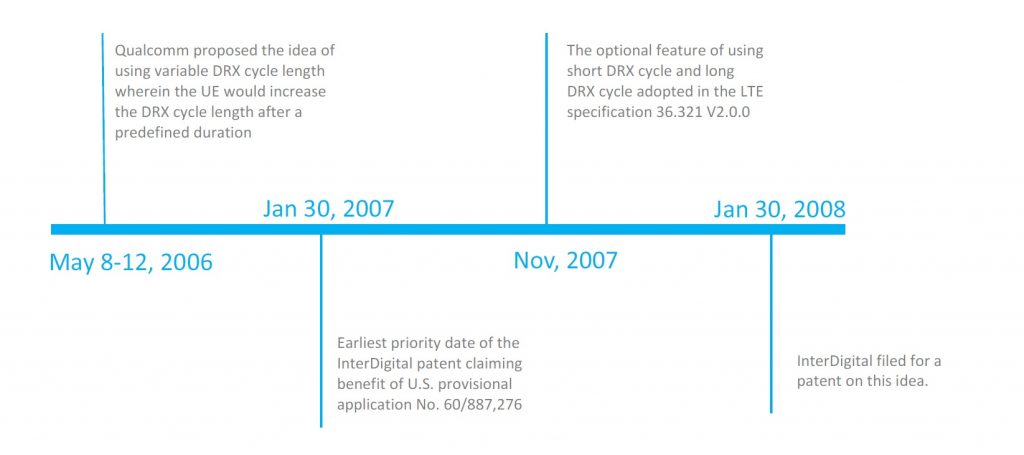Cellular standard essential patents (SEPs) have been at the center stage of many litigations, arbitrations and licensing disputes in the last couple of years. European Telecommunications Standards Institute (ETSI) defines essential IPR as follows:
“ESSENTIAL” as applied to IPR means that it is not possible on technical (but not commercial) grounds, taking into account normal technical practice and the state of the art generally available at the time of standardization, to make, sell, lease, otherwise dispose of, repair, use or operate EQUIPMENT or METHODS which comply with a STANDARD without infringing that IPR.
Unlike other technologies (e.g. User interface) where the manufacturers have a choice to design around the technology of the patent, in case of SEPs, there is no possible way to avoid infringement and still comply with the standard. On the other hand, non-compliance with standard is a commercially non-viable option. This situation gives the SEPs holders a great leverage to assert their licensing terms. While there have been several cases and rulings in favor of SEP licensees that put some restrictions on the SEP holders regarding their FRAND licensing commitments as well as their abilities to exercise an injunction for infringement of SEPs, lack of clarity on FRAND terms still make the negotiations tough for a potential SEP licensee.
 The traditional lines of defense against SEPs (non-essentiality and invalidity) continue to remain effective. However, all the patents that survive these two tests are not equally important and do not merit the same royalty. There has been rising interest in exploring other aspects of SEPs that affect their true worth. These aspects rely on the fact that a SEP is implemented (and hence infringed) not only due to its unique advantages, but also due to the fact that the technology of the SEP was selected (among various other alternatives) to be incorporated in the standard even if the incremental advantage was non-substantial or even non-existent in some cases. Therefore, the true worth of a SEP should be determined based on the degree of superiority it had compared to other alternatives at the time of standard development. While the tasks of evaluating a technology’s superiority compared to other alternatives may sound complex, it is very much doable in the context of cellular SEPs due to the transparency offered by 3GPP / ETSI in the process of standard development and the appropriate documentations. In some cases, the study of standard development process reveals that the owner of the patent was not the entity that introduced the corresponding feature in the standard, but was merely the first one to file for a patent on a jointly developed concept or even someone else’s concept, which raises serious validity issues.
The traditional lines of defense against SEPs (non-essentiality and invalidity) continue to remain effective. However, all the patents that survive these two tests are not equally important and do not merit the same royalty. There has been rising interest in exploring other aspects of SEPs that affect their true worth. These aspects rely on the fact that a SEP is implemented (and hence infringed) not only due to its unique advantages, but also due to the fact that the technology of the SEP was selected (among various other alternatives) to be incorporated in the standard even if the incremental advantage was non-substantial or even non-existent in some cases. Therefore, the true worth of a SEP should be determined based on the degree of superiority it had compared to other alternatives at the time of standard development. While the tasks of evaluating a technology’s superiority compared to other alternatives may sound complex, it is very much doable in the context of cellular SEPs due to the transparency offered by 3GPP / ETSI in the process of standard development and the appropriate documentations. In some cases, the study of standard development process reveals that the owner of the patent was not the entity that introduced the corresponding feature in the standard, but was merely the first one to file for a patent on a jointly developed concept or even someone else’s concept, which raises serious validity issues.
Let me demonstrate a few examples of what can be uncovered through the study of standard development process and how it affects the perceived value of a SEP. I picked up a few patents from one of the most actively licensed portfolios in the cellular SEP space i.e. InterDigital and provide specific findings.
Example 1: USP 6,973,579
The ‘579 patent relates to UE specific scrambling / descrambling code for high speed shared control channels (HS-SCCH). A ½ rate convolutional encoder processes 16 bit user identification code with eight appended zero bits to produce a 48 bit code for use in scrambling / descrambling a high speed shared control channel (HS-SCCH).
1. An apparatus comprising:
an input configured to accept a user identification comprising L bits; and
a ½ rate convolutional encoder for processing at least the bits of the user identification by a ½ rate convolutional code to produce a code used for scrambling a high speed shared control channel (HS-SCCH).
Essentiality
The patent appears to be essential to UMTS standard specification 25.212 (see section 4.6.7).

Superiority
At the time the topic of UE specific scrambling code was discussed at 3GPP (RAN WG 1), several proposals were made (e.g. R1-02-0715 by InterDigital, R1-02-0771 by LGE, R1-02-0723 by Lucent, R1-02-0541 by LGE etc.).
As per the minutes of the meeting RAN WG1#26, the main reason for selection of the InterDigital proposal was its simplicity and consistency with Release 99 specification and lack of support by the members for the alternative scheme, rather than any significant performance advantage. Below is an excerpt from the meeting minutes:
After having all these paper presented, Chairman stated that we should stick to something simple and something that is already existing in R99 specifications unless there is really really good reason to use new schemes. Chairman asked the floor if people think that we should have the time variant scheme. There were no supporting comments made. Having this, chairman concluded we should take the scheme proposed in R1-02-0715 (InterDigital), that is, ½ rate convolutional code and puncture it to 40 bits
Further, InterDigital itself identified two leading choices in its proposal giving similar performances. The patent covers the first choice only. See the below excerpts from InterDigital proposal:
“We have identified the following two leading choices:
- Option-1: Use ½ rate convoluational code and puncture to 40 bits
- Option-3: Use a 24 bit CRC code and the16 bit UE ID, where the 24 bit CRC is generated based on a 8 bit CRC which is calculated from the 16 bit UE ID
The two leading candidates have the same minimum distance, dmin= 8. Simulations indicate that they give similar performance. The Option-1, the convolutional approach has a small advantage that it results in a smaller number of instances of the minimum distance condition. However, either of them could be qualified as a preferred candidate and the choice between the two for the UE specific masking for HS-SCCH should be based on implementation considerations.”
Conclusion re: the ‘579 patent
InterDigital’s proposed technology was not identified by 3GPP as the best performing one when compared to other technologies available at the time of standard development. There was a potentially better performing alternative available (the time variant scheme from LG), but it lacked support from other members. Further, InterDigital’s own proposal provided another option giving similar performance. However, once InterDigital’s proposed technology (first option) was selected for inclusion in the standard (In May 13, 2002) for the reasons stated above, InterDigital filed for a patent on the same about a month later (on July 1, 2002).
So, while InterDigital’s patent seems to be essential to the UMTS standard and would likely be infringed by any UMTS compliant handset, it doesn’t offer any performance advantage compared to other options available at the time of standard development. Putting it differently, if a handset manufacturer is now given a hypothetical choice to pick between InterDigital’s technology and alternative technology while still be compliant with the standard, he has very little motivation to go for the InterDigital’s technology. Therefore, InterDigital’s patent does not merit the same royalty that many other essential patents do as a result of their superior technology compared to other alternatives available at the time of standard development.
Example 2: USP 8,238,260
The ‘260 patent relates to use of multiple DRX levels having different DRX cycle lengths wherein a UE switches from a first DRX level having a first DRX cycle length to a second DRX level having a second DRX cycle length upon expiry of a timer.
- A method for controlling discontinuous reception (DRX) in a wireless transmit/receive unit (WTRU), the method comprising:
the WTRU receiving a DRX configuration comprising a plurality of DRX levels, each of the plurality of DRX levels comprising at least one DRX cycle length;
the WTRU operating at a first DRX level of the plurality of DRX levels;
the WTRU determining that a WTRU timer has expired; and
responsive to determining that the WTRU timer has expired, the WTRU transitioning from the first DRX level to a second DRX level of the plurality of DRX levels without receiving explicit signaling from a base station to transition from the first DRX level to the second DRX level, the second DRX level comprising a second DRX cycle length that is a multiple of a first DRX cycle length of the first DRX level.
Essentiality
The patent may not be truly essential as it seems to cover an optional feature of the LTE standard specification 36.321 (see section 5.7). However, it would still be infringed by devices implementing that optional feature.



Originality
InterDigital does not seem to be the first one to propose the idea of using variable DRX cycle length wherein the UE would increase the DRX cycle length after a predefined duration (e.g. using a timer). In fact, Qualcomm proposed this idea in a technical contribution (R2-061200) made to RAN WG 2 in May 2006 (well before the priority date (Jan 30, 2007) of the InterDigital patent). See the below excerpts from Qualcomm’s technical contribution:
3 Paging delay for contiguous data session
………………………….
In general it is sensible to assume that likelihood of incoming paging to the UE is higher immediately after the UE enters LTE_Idle. We propose a scheme in which DRX cycle is shorter right after the UE enters LTE_Idle for a predefined duration and then becomes longer afterwards. The figure-1 below depicts the scheme. The network and the UE use a short DRX cycle length in phase 1 and normal DRX cycle length in phase 2. This way the UE is more responsive for the case that data received contiguously, where the delay can be critical for service continuity.

Figure-1: Phased DRX cycle length scheme
Conclusion re: the ‘260 patent
The InterDigital patent has two major issues. One, it covers an optional aspect of the LTE standard i.e. all LTE compliant devices may not infringe the patent. Two, the central idea of the patent was first proposed by Qualcomm. Below is a timeline of events related to the feature of the patent:

Given the earlier date of Qualcomm’s technical contribution, invalidity arguments may be built against the InterDigital patent. The Qualcomm’s technical contribution was neither cited by the patent applicant nor identified by the patent examiner during prosecution. Further, it is evident that InterDigital filed for a patent only after the feature was adopted in the standard revealing strategic patent filing by InterDigital.
Recommendations
The above two analyses are exemplary and do not cover all different findings that may be revealed through the analysis of technical contributions and standard development process. This is a task every SEP licensee must perform, whether involved in a litigation or just having a friendly licensing negotiation. On the other hand, patent holders may also perform this tasks on their portfolio to showcase the value / contribution of their patents and earn more credibility. In the past, I have been involved in several studies where these analysis have resulted in valuable findings. I have listed below some of the most common findings that the involved parties look out for:
- There were several alternatives giving similar / slightly better / slightly worse performances at the time of adoption of the patented feature in the standard (Example 1 explained above).
- The patent owner was not the first one to propose the corresponding feature in the standard (Example 2 explained above).
- The high level essentiality analysis seems to suggest that the patent covers a major feature of the standard, but upon detailed review of the standard development timeline and various technical contributions, it is revealed that the patent actually covers a small improvement in the major feature of the standard.
- The patent owner was the actual contributor of the idea and introduced the corresponding feature in the standard. Other alternatives were inferior compared to the patented idea.
- There was no alternative to the idea proposed by the patent owner and the technical contribution was unanimously approved by the 3GPP work group.
The first three findings significantly diminish the value of the patent and are good tools for potential licensees to use for negotiations. The last two findings affirm the value / strength of the patent and can be used by the licensor to demonstrate their contribution in the process of cellular standard development.
Disclaimer
The opinions expressed in this article are author’s personal opinions and do not constitute a legal advice. The author or his firm Concur IP Consulting is not involved in practice of law.

![[IPWatchdog Logo]](https://ipwatchdog.com/wp-content/themes/IPWatchdog%20-%202023/assets/images/temp/logo-small@2x.png)

![[Advertisement]](https://ipwatchdog.com/wp-content/uploads/2024/04/Patent-Litigation-Masters-2024-sidebar-early-bird-ends-Apr-21-last-chance-700x500-1.jpg)

![[Advertisement]](https://ipwatchdog.com/wp-content/uploads/2021/12/WEBINAR-336-x-280-px.png)
![[Advertisement]](https://ipwatchdog.com/wp-content/uploads/2021/12/2021-Patent-Practice-on-Demand-recorded-Feb-2021-336-x-280.jpg)
![[Advertisement]](https://ipwatchdog.com/wp-content/uploads/2021/12/Ad-4-The-Invent-Patent-System™.png)







Join the Discussion
No comments yet.